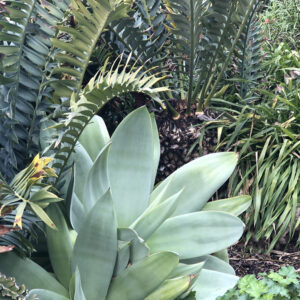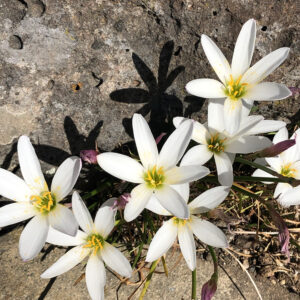
The new year brings much needed moisture, and the rainy season is in full-swing in Northern California! However, concern over extreme weather conditions continues, not just in California but around the country, and the world. Whether we face a drought or deluge environment, it is still important to conserve water as it is a precious resource. What can we do locally to conserve water? Planting a waterwise garden is one way to reduce water usage in the home garden, and surround yourself with a bounty of unique plants!
Find inspiration in the Garden’s Waterwise Entry Area
Step through the Garden’s main gate and you will be surrounded by the lush, inviting beauty of the Waterwise Entry Garden. This planting is different from the Garden’s nine geographically planted collections because it contains a mix of species from subtropical, desert, and Mediterranean climates. While these drought-tolerant plants may never be found together in nature, they form a collection that grows well in the San Francisco Bay Area’s mediterranean climate with wet winters, dry summers, and moderate temperatures year-round.

Winter blooming cat’s-tail aloe (Aloe castanea, shown here in bud) located in the Waterwise Entry Garden
Assembled in the area are over 170 species, chosen for maximum visual impact and appeal, unified by their tolerance for low-water conditions. Dynamic sculptural forms are on display from the winter-blooming cat’s-tail aloe (Aloe castanea) to the mature specimens of several rare cycads (Encephalartos spp.), along with the strikingly beautiful yucca (Yucca rostrata) with its narrow gray-blue leaves. The spiky textures of these plants are combined with soft, flowing grasses and sedges, drawn from Mexico, Argentina and California, among others. A muted color palette of blues and grays contrasts with the pop of color from various species, blooming year-round in shades of white, yellow, orange and red.

Varied texture and shape provides visual interest in a waterwise garden.
Front to back: Heuchera amoena, Agave sp., Encepharlartos arenarius, Pitcairnia ringens.
Combining engaging texture, form and color, creates year-round interest in the Waterwise Entry Garden. Visit the Garden to see this collection of subtropical and arid climate plants, fondly known as ‘arid exotica’. It’s a great place to find planting ideas and inspiration for your home garden.
A few tips to consider when planting a drought-resilient home garden:
1. Choose plants that are appropriate to the micro-climate.
2. Group plants into zones by their water needs.
3. Plant in fall and winter to establish plants during the rainy season.
4. Use mulch – wood chips, bark, compost, and gravel – to keep moisture in the soil.
5. Irrigate carefully. Check to be sure the water is going into the ground, not onto pavement.
6. Remove weeds that compete for water.
7. Grow thirsty plants in containers.

Fall blooming rain lilies (Zephyranthes candida).
